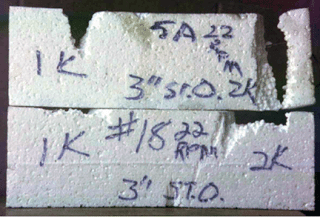Simple cleaning nozzles, of the sort that are used in most pressure washers, have historically produced fan-jets that spread in one plane away from the orifice. There are a large variety of these on the market, of varying flow rate and geometry, and it was an initial challenge to find a simple way of relatively ranking the jet quality. Our initial answer, for the first cut, was to take blocks of polystyrene foam and traverse these at a fixed speed under the jet at different pressures and distances from the nozzle. This foam is very easily cut by a jet. So the tests were carried out at 1,000 psi and 2,000 psi, which is the range of pressures of the electrically powered pressure washers found in most hardware stores these days. The difference between two nozzles that were nominally supposed to achieve the same performance was striking:


Figure 1. Comparison of performance between a “better” fan nozzle (top) and a “poor” one (lower sample) when cutting polystyrene packing foam at low pressures.
As you may note at 1,000 psi the poor design was barely able to remove the surface of the polystyrene, rather than cutting deeply into it, as was the case with most of the nozzles tested, and as exemplified in the top cuts.
My point today however, is not the inherent faults in the design of the nozzle shape itself, but rather to highlight the problems that the particular design had, as a result of the way that water was fed into the orifice.
For in this case, unlike many of the conventional nozzles, where the flow is directed directly at the orifice down a channel aligned with the orifice, the nozzle were small discs arrayed along a spray bar, of the type that is used for car and truck washing rigs where a single channel feeds a number of sprays.
The flow in this case is primarily along the distribution manifold, and, as such, perpendicular to the axis of the resulting jets. When the water, therefore, exits from the individual nozzles it retains a component of this lateral velocity, and this tears the jet apart relatively close to the nozzle. The results are evident in the cut made in the lower half of Figure 1.
It is surprisingly easy to remedy this. A short tube inserted behind the nozzle orifice, and protruding up into the manifold channel allows the water some chance to collimate in the direction of flow before it accelerates through the nozzle orifice, and the result, relative to the original cut is quite significantly better.
Not that short lengths of tube are completely effective, but they are a start. One of the more effective means of getting a water jet to move as a cylinder in short jets (such as those seen at Disneyworld and at Detroit Airport is to run the water from the supply pump through a small stabilizing chamber and then pass it into a collimating tube full of drinking straws (or their technical equivalent) which sit just behind the nozzle. Providing the geometries are properly selected you can get the very smooth cylinders of water that are a feature of the jumping streams.
A similar structure lies upstream of the the nozzle at the Gateway Geyser across the river from the Gateway Arch in St. Louis. The fountain shoots a jet of water to the same height (630 ft) as the Gateway Arch on the other side of the river, and to quote Wikipedia:
the Gateway Geyser was designed and constructed by St. Louis–based Hydro Dramatics. It was completed in 1995 at a cost of $ 4 million. Three 800-horsepower (600 kW) pumps power the fountain, discharging 8,000 U.S. gallons of water per minute (50 L/s) at a speed of 250 feet (76 m) per second. The fountain has an axial thrust of 103,000 pounds-force (460 kN); water is jetted out of the 6-foot (1.8 m)-tall aerated nozzle at a pressure of 550 pounds per square inch (3.8 MPa).
These are more complex flow straighteners than the simpler ones that are used in low pressure cleaning systems, and with considerable effect in controlling the jet flows from the monitors of hydraulic mining equipment. By channeling the water into a multitude (perhaps 200) small diameter channels and then recombining the water at the nozzle the resulting flow is laminar.
Where the water flow is much lower, such as when being used in an ultra-high pressure system, the flow can be stabilized by allowing a long straight run-up of the pipe leading into the nozzle. (Typically the rule of thumb was that the length should be around 125 pipe diameters, however work at the U.S. Bureau of Mines showed that the length of straight section did not need to be this long – a length of around 4-inches proved effective.)


Figure 2. The improvement in jet performance with a straight inlet section (after Kovsec et al*)
A similar improvement can also be seen when the flow conditions are correct when working with higher pressure jets.
As a general rule, however, such care is not taken in the construction and lead-in to the nozzles, and the jet will begin to taper and reduce in effective diameter from the time that it leaves the nozzle.
I’ll talk more about that, next time.
*Kovscek, P.D., Taylor, C.D. and Thimons, E.D., Techniques to Increase Water Pressure for Improved Water-Jet-Assisted Cutting, US Bureau of Mines RI 9201, Report of Investigations, 1988, pp 10.



